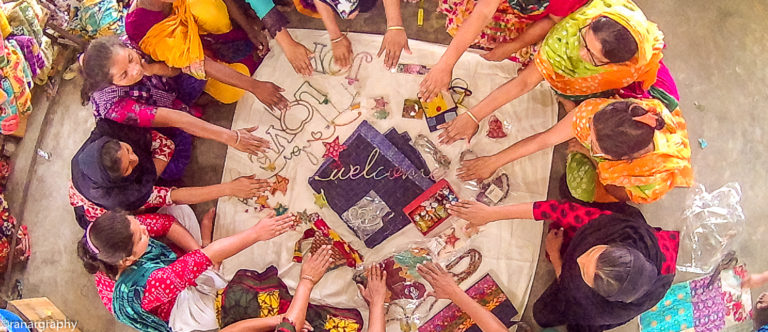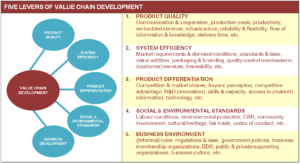By Guest Blogger, Nishant Das
What is a value chain?
A value chain is the entire system of processes that adds value to the customer at each stage, from transforming raw materials into a final product, delivering it to the final consumer, and final disposal after use.
This chain is comprised of interdependent actors that work together in both vertical linkages (those that perform different functions like artisans and a retailer), and horizontal linkages (those that perform the same function, like many artisans working in a cooperative).
Why thinking with a value chain perspective matters?
Ideally in a ‘healthy’ value chain, the demand is ‘pulled’ from the final consumer, and this is communicated back through the value chain. In a ‘sick’ value chain (or simply a supply chain), producers ‘push’ their products through the chain to the final consumer.
Value chain thinking requires a broader understanding of an entire chain and not simply one or two actors. This works to improve efficiency in the chain, works to help all the stakeholders produce products and services that are relevant and in demand, creates an atmosphere of collaboration that fosters innovation and mutual gains, and it strengthens the market system which increases competitiveness and resilience in challenging contexts.
How to apply a value chain approach.
1. Analysis:
Begin with broad analysis of the chain to identify bottlenecks. There are various tools that can be used for this type of analysis, so pick one that you are comfortable with and that is appropriate.
A SWOT analysis is good to identify internal Strengths and Weaknesses, and external Opportunities and Threats.
The Five Levers model provides a thorough framework that dissects a value chain into different components.
2. Customer Focus:
Focus on customer needs throughout the chain and work backwards to meet these needs. Customers include but are not limited to: input suppliers, manufacturers, wholesalers, retailers, consumers…
3. Listen:
Listen to stakeholders and customers directly involved in the chain, and also others indirectly involved in the chain like community members as their insight helps inform a broader perspective in which the value chain operates in.
4. Transparent Communication:
Communicate market information back to all actors in the chain, right back to input suppliers, so everyone is working together to make something the market will ‘pull’.
5. Participation:
Foster participation of all stakeholders so that everyone can contribute towards the sustainability of the market system and to increase innovation. This can be done through a variety of creative ways on an ongoing basis, but it is important to periodically gather all the stakeholders together in the same physical space to meet.
6. Relationships:
Go beyond the technical relationship and invest in the emotional dimension. This increases the social capital of the chain and trust between different actors, thus making the chain work better.
7. Mutual Gains:
Make sure everyone benefits, but have a preference to make it inclusive to the vulnerable and poor so that the society around benefits and thus improves the context in which you operate.
8. Resilience:
Seek ways to strengthen linkages and increase interdependence across the chain. By working to develop and integrate diversified stakeholders and alternative products/services, resilience is improved as the risk of dependency on a narrow scope of customers is decreased.





